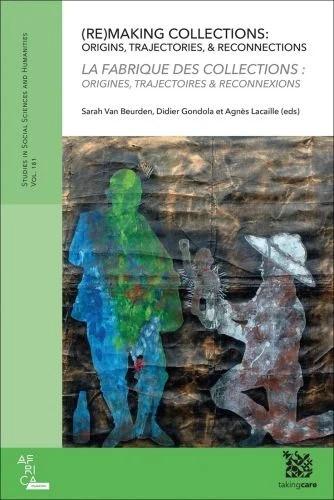
case, the sculptor shook his head. They were happy that the mask had been preserved but were dedicated to their own art and liked to believe that they had surpassed Gabama. Two suggested that they would really like to see a museum with THEIR works on the wall next to a label with THEIR names. Even though their local reputations rested on works carved for masked dancers, the white cube gallery lived in their imaginations as a goal... for their own sculptures.
The return of African cultural heritage from European and American collections to African nation states has been debated in political, moral, legal, and psychoanalytic terms.2 It is important also to consider the aesthetic and religious dimensions of the issue – how would the return of works of art affect the practices of contemporary tradition-based artists and religious practitioners? Historically, in many Central African societies, an expectation exists that masks, statues, textiles, and buildings all ‘die’ (kufua), just as people do.3 These works die for religious, political, and aesthetic reasons. They die sometimes because they have too much power to be tolerated for long periods. They die because prize works can become so emblematic of social and cultural identity that they become vulnerable at times of change or conflict. And sometimes they die, as Nigerian novelist Chinua Achebe has observed, because collections can inhibit the creativity of future generations. This essay probes the complex biographies of works of art among self-identified Pende community members (DRC), the tension between ephemerality and permanence, and how expectations for an object’s life history may be shifting in the wake of the ongoing debate about restitution.4
Ephemerality and creativity
Reflections on ephemerality in art history are often sparked by a certain puzzlement about the artist’s choice of materials variously described as ‘organic,’ ‘perishable,’ ‘unstable,’ or ‘fugitive.’ Reflecting a bias since the
2. Mobutu, 1973, columns 18, 22; Okediji 1998; Sarr & Savoy 2018; Diawara 2020; Akpang forthcoming. Sarah Van Beurden kindly made available her copy of President Mobutu’s speech.
3. E.L. Cameron and Z.S. Strother, ‘Narrative,’ for a proposed exhibition at the Museum for African Art, ‘Art that Dies: Iconoclasm, Transformation and Renewal in African Art,’ which asked what role duration plays in the experience of the visual arts (2005-2006).
4. This essay is based on 32 months of study with Pende chiefs, patrons, artists, and historians in (what is now) Kasaï and Kwilu provinces (1987-1989) followed by periodic visits, conversations, or emails with Pende patrons and artists since 2006. I thank my mentors for their guidance: Kubalumona, luthondo. I also thank the editors, peer reviewers, and Susan E. Gagliardi for their thoughtful engagement with the text. For in-depth studies on masks, see Strother 1998; 2020. On colonial arts, see Strother 1998: 229-263; 2016: 199-241.
In the text, ‘Pende’ refers to self-identified members of a community usually conceived to be founded through descent from a shared maternal ancestor and constituted through migration in the 17th century from central Angola to what is today southwest DRC. The time depth and currency of such an identity is open to debate given the investment of the colonial regime in mapping ethnicity. Nonetheless, whatever its origins, a Pende identity is actively invoked in many postcolonial settings.
Italian Renaissance if not earlier in favor of elite materials such as marble and metalwork, scholars feel a need to justify the decision to fashion works of art with a limited lifespan. And it is a choice. Although some argue in favor of environmental determinism, Fang and Kota-speaking peoples living in the dense forests of Gabon were able to preserve reliquary figures that were carved from hard wood by saturating the wood with palm oil and/or by sheathing them in copper, the patina of which renders the wood toxic to insects.5 One of the reasons that the so-called ‘Benin bronzes’ have played such a leading role in the restitution debate since 2017 is not only the depth of documentation surrounding their theft and auction history but also their exceptional biographies. The Edo royal family safeguarded over a thousand metalworks for 300-400 years and this history can be easily integrated into a Eurocentric museographic narrative about the imperative of preserving physical heritage for future generations.
Beyond the choice of materials, as Allyson Purpura writes, ‘the ephemeral amplifies the present by giving it a temporal frame’ (Purpura 2009: 14). Ephemerality in modernism refers to the embrace of contemporaneity. Ephemerality in contemporary art is framed as a transgressive rejection of longevity and commodification in the art market. It is a sign of how threatening ephemerality is to the regime of permanence that these positions are riven by contradiction. In his role as art critic, Charles Baudelaire may have embraced ‘the ephemeral, the fugitive, the contingent,’ but he is adamant that it is the role of the artist to ‘distil the eternal from the transitory’ (Baudelaire 1964 [1863]: 12-13; my emphasis). Contemporary artists such as Robert Smithson, Ana Mendieta, and Andy Goldsworthy may accept impermanence in their installations or performances but rely on photographs to ensure the duration of their works.
But how do African societies conceptualize ephemerality (Purpura & Kreamer 2009-2010)? The most piquant discussion of the issue concerns the Igbo of southern Nigeria. Herbert Cole (1969: 41) observed that Igbo arts value transience over permanence. In 1984, author Chinua Achebe explained with unmatched eloquence the importance of prioritizing the impulse to creativity over the resulting work of art:
‘the very concept of collections would be antithetical to the Igbo artistic intention. Collections by their very nature will impose rigid, artistic attitudes and conventions on creativity which the Igbo sensibility goes out of its way to avoid[…] When the product is preserved and venerated, the impulse to repeat the process is compromised. Therefore the Igbo choose to eliminate the product and retain the process so that every occasion and every generation will receive its own impulse and kinesis of creation’ (Achebe 1989: 63-64).
5. LaGamma 2007: 107. Copper is a potent inorganic pesticide and fungicide. The construction industry will sometimes lay fine mesh screens of copper wire over wood surfaces to protect them from termites, a strategy not unlike the sheathing of Kota and Mahongwe reliquary figures with tightly-fitted copper strips and wire.
In the 1940s, Kaseya Tambwe Makumbi from Kandolo-Mututua (Njila) created a new form of roof finial depicting a relatively naturalistic young mother cradling a child on her left. Likely inspired by Catholic statues of Mary holding the baby Jesus, Kaseya’s appropriation took on new meanings rooted in complex local iconography (Strother 2015-2016: 141-143). The mother-and-child form established Kaseya as the most sought after sculptor for Eastern Pende paramount chiefs for over twenty-five years. His works attracted European as well as Pende tourists and enabled Kaseya (like Gabama) to draw students and to work successfully in a dual market. RMCA registered a fine example in 1950 (fig. 4).
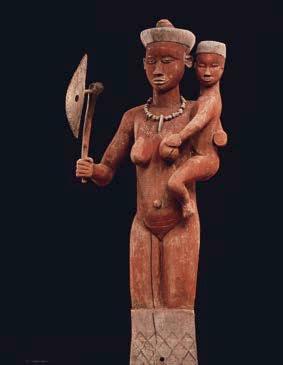
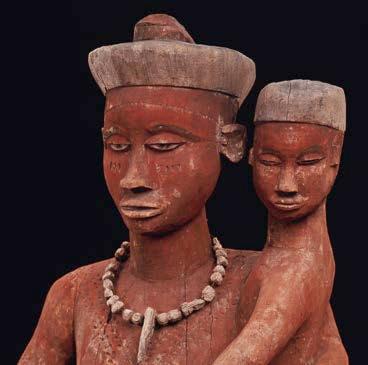
In the mid-1950s, he was a favorite of Agent territorial Charles Souris, who opened a small museum in Kitangua (an administrative as well as Catholic center among Eastern Pende) and he consequently became a protégé of Robert Verly, who promoted his work in the Ateliers sociaux d’Art indigène du Sud-Kasaï and in a small museum opened in Tshikapa for the encouragement of ‘native’ art (1956-1959). A photo from ca. 1956 shows Kaseya (on the left) working in front of his roadside cabana (fig. 5.).
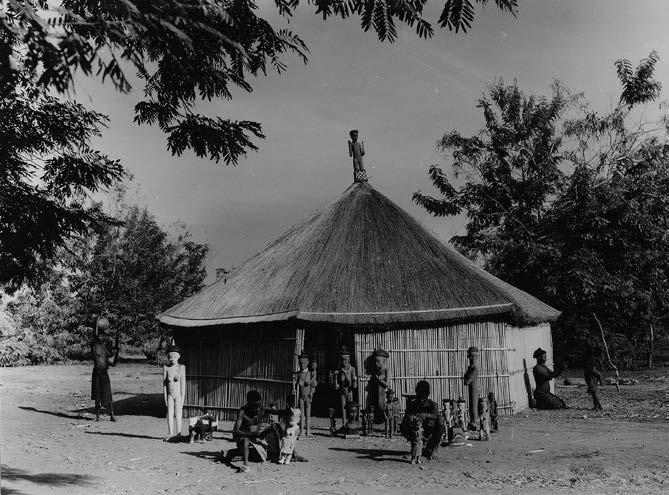
Figure 5. Kaseya Tambwe Makumbi (central left) displays his wares in front of a roadside cabana promoted by the Ateliers sociaux d’Art indigene du Sud Kasaï organized by Robert Verly. (EP.0.0.3002, RMCA collection; photo C. Lamote (Inforcongo), s.d., CC BY 4.0.)
In the back are two mother-and-child statues adapted to stand on small plinths. One has an elongated vulva such as one would never see on a mounted statue, presumably carved to enhance the erotic appeal to foreigners. There are a multitude of other sculptures, some reflecting indigenous prototypes and others not. Extraordinarily, Kaseya has mounted on the roof a unique male figure holding a carving adze, which Verly described as a ‘sign for the studio.’ The right to display anthropomorphic sculpture in any form was and is a prerogative strongly policed by paramount chiefs. One can only conclude that Kaseya was closely identified with the colonial state and therefore untouchable. Notwithstanding, he remained very popular locally and many eyewitnesses recounted vivid memories of his work in situ. In 1974, he received a commission for the Institut des Musées nationaux in Kinshasa (Van Beurden 2015: 138, fig. 4.1).
Congolese were not usually invited into colonial museums and few Pende have seen the collections in Kinshasa. Judging from my conversations with sculptors, Kaseya might well have appreciated the idea of his works being preserved… elsewhere. At home, once the sculptures left his hands to be mounted on a chief’s house, they were presumed to be power objects, containing a protective human spirit to watch over the community by a nganga
(ritual specialist). Charged with spirit, such works are dangerous and, for this reason, most rural Pende have a horror of making anthropomorphic carvings long-lived. When asked why one should not make power objects out of stone, the regionally infamous nganga Kakoko protested, ‘You don’t want to make it eternal! When[Chief] Kombo dies, a new Kombo must make his own. Who would use the old figure? People are afraid to have all of those spirits around. [Who would want them] tied eternally?!’ Another respected practitioner, Mukishi Loange ‘Socrate,’ explained that when the chief’s architectural sculpture is in poor condition, or the chief dies, the spirit (kivule) is liberated. Its work is finished and it is free to go.11
Sylvester Ogbechie (2005: 68) warned that even when objects disappear, one must be careful before concluding that the knowledge system that supported them has vanished. When I began research in DRC, 1987-1989, there were plenty of chiefs’ houses but not one displayed any of the architectural sculpture photographed in situ the 1950s-1960s. Many said that mounting a statue was too dangerous as it could provoke accusations of sorcery that might spiral out of control. However, with the fall of Mobutu, no one could enforce local hierarchies any longer. A great number of small chiefs purchased their ‘independence’ and insisted on having the ultimate insignia of rank – a statue on the roof (kishikishi) (fig. 6). The community was proud enough of their rise in status to support the chief’s decision.
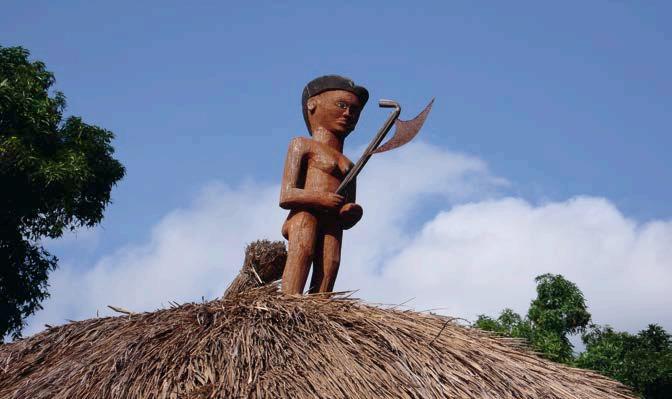
11. Interviews with Kakoko and Mukishi Loange, Ndjindji, DRC, 1987. Both men belonged to the Ndeke generation, initiated ca. 1931-1933.
It is interesting to analyze the finial commissioned by Chief Mudinga in 1996 after a hiatus of maybe twenty years in the mounting of kibulu sculpture in the region. The young sculptor Munganga Sh’a Libako carved his statue in the form of a young woman standing with an axe (kuba), a recurring motif documented regularly beginning in the early 1900s. The only hint of Kaseya’s influence is in the modeling. The sculptor was counseled on a straight-forward and positive iconographical program. Mudinga’s candidacy was disputed and, as the chief explained, the image underscores that he was properly invested because the figure carries the distinctive axe with rounded blade wielded during a test when a candidate must behead a ram with a single blow. On the other hand, the female image reminds the chief daily that he should serve as the ‘mother of the clan.’12 As Ogbechie foresaw, a living knowledge system can generate a recognizable iconographical program without a visual record because the ritual or cultural logic remains intact. As to the carving, it is possible that the international market kept alive certain skills as some men continue to produce anthropomorphic sculpture discreetly out of view of most passersby.
Although communities such as Mudinga’s shared the chief’s pride in his new status, they still took comfort in the rule barring maintenance so that the rooftop sculpture would have a defined lifespan of around a decade. If the chief wished to sell the work once it hit the ground – that was his business – so long as it vanished. Subsequently, having celebrated their ascension in rank, few communities have authorized the replacement of these sculptures once they fell. Although capable of flaring back to life, the kishikishi is a prototypical example of objects that ‘die’ because they have too much power to be tolerated indefinitely.13
Ephemerality under the regime of permanence
Under globalization, there has been relentless pressure for the peoples of the world to conform to the hegemonic regime of museological permanence. Even privileged American artists are not immune. The morals clause of the American Visual Artists Rights Act (1990) states that ‘the preservation of the cultural property supersedes the individual wishes of the artist’ (Hornbeck 2009: 57). Responding to criticism of cultural imperialism, UNESCO passed the 2003 ‘Convention for the Safeguarding of Intangible Heritage,’
12. Chief Mudinga (Kamusa Albert), pers. comm., Nyanga, DRC, 2007.
13. It is likely that most power objects have a limited life span. In Mali, Bamana Kɔmɔ masks are also power objects. Kassim Kone reports that people can become uneasy when there is a buildup of sacrificial blood on Kɔmɔ masks. ‘The owner can decide: it’s time for it to die.’ Or, if he’s ill, he may decide that no one in the family has the expertise to manage it safely. In that case, he may decide to place the headpiece in an abandoned beehive because no one will dare touch such a thing. Eventually, the energy in the object will dissipate and the termites will eat it with impunity and the rain will wash away any traces. Alternatively, the caretaker for the object may go out in a canoe and drop it into the water, apologizing, with a polite fib, ‘I’ll come back and get you.’ He will do this to protect his family. Kassim Kone, pers. comm., 9 March 2021.
including performances of theater, music, rituals, etc. Many feared that the listing process would ‘fossilize’ dynamic cultural practices and in many cases it has. By focusing on the presence or absence of physical objects, the initiative has failed to address the temporal dimension of change although concern about this issue was expressed from the beginning (Nas 2002: 139-140). In one damning critique, Ferdinand de Jong accuses UNESCO policy of not being able to take the contemporaneity of Kankurang Masquerade (Senegal, The Gambia) seriously, instead casting it as ‘a potential pharmakon to heal the wounds of postcolonial modernity. The operation is not forward-looking but focused on the restoration of selected values associated with an imaginary precolonial past’ (2007: 175). De Jong articulates precisely the dangers of restitution initiatives that exchange one colonialist paradigm for another when they presume the desirability of unchanging objects and fail to consult with stake-holders outside the museum apparatus.
Ephemerality itself should not be construed as an unchanging cultural ideal located in ‘an imaginary precolonial past.’ Its power should be to force us into the present. I asked Chika Okeke-Agulu to what degree Achebe’s argument that Igbo eschew private collections out of concern to nourish the ‘kinesis of creation’ might hold true today. He responded by describing multiple constituencies. 1) Igbo country is now full of churches, especially Pentecostal congregations and there are ‘frequent orgies of burning objects’ associated with so-called pagan practice. ‘This is ongoing. Of course, everyone has the right to change their religion.’ 2) Nonetheless, there are still people with strong ties to Igbo religious and cultural practices, even if they don’t care about restitution per se. Whenever members of Okeke-Agulu’s home community needs to commission a new masquerade, they contact him and expect him to contribute. What Achebe described was informed by a theology of reincarnation. However, it is important to understand that Igbo associations are also fiercely competitive and this factor drives them to commission new works responding to contemporary tastes that surpass in quality or emotional impact preexisting works. 3) And yes, there is also a new class of middle-class culture whose members view museums as educational institutions. He mused on an Igbo cultural predisposition to savor contradiction: ‘Old things need to be thrown away. But what do you do? They simultaneously value newness but accept that it’s necessary to use the old to teach the new.’14
I share Okeke-Agulu’s belief that a theology of reincarnation lies behind the predilection to give works of art a defined lifespan. Mukishi Loange said as much when he advised that a power object should be ‘made in wood because man’s life on earth is not eternal. It is not made in metal: how long will the owner live?’15 Nonetheless, the constituencies that Okeke-Agulu enumerates for the arts today have their parallels in Pende circles: the églises de reveil; the communities invested in the mukanda or chiefly power; the middle-class
14. Speaker’s emphasis. Chika Okeke-Agulu, pers. comm., 15 March 2021.
15. Mukishi Loange, pers. comm., Ndjindji, DRC, 1987.
and permanence in the politics of restitution
active in the Pende Cultural Center in Kinshasa, probably the most important contemporary venue for masquerades. Other stakeholders include artists working in tradition-based arts, who crave recognition under their own names (fig. 7).
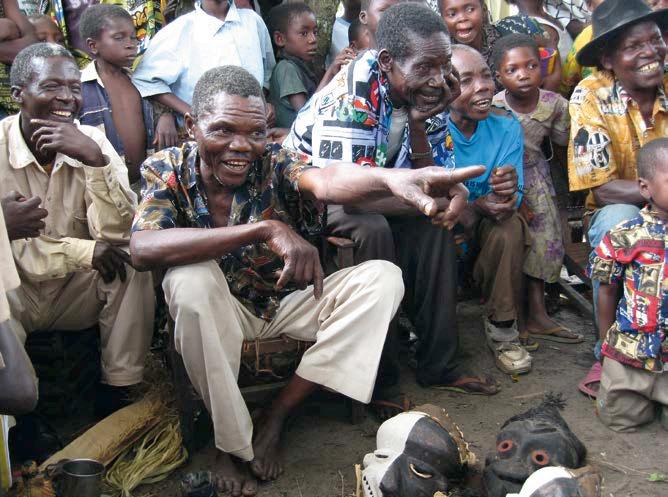
Figure 7. Mashini Gitshiola (1949 2017) did not live to see a museum in Nyoka Munene but he did take pleasure in seeing his own work reproduced in Inventing Masks. (Photo and © M. Goertz, Nyoka Munene, DRC, 2006.)
A philosophical and aesthetic commitment to ephemerality facilitated a remarkably swift integration of sculpture into a cash economy in the Pende region.16 The fact that this serendipitous relationship developed during an occupation that was often brutal, especially in the 1910s-1930s, does not license dismissal of the decisions made by Pende artists and patrons during that period, nor disregard for the wishes of their descendants. That said, a cultural appreciation of ephemerality must never be used to justify those ‘very clear instances of acts of expropriation that injured the cultural memories of
16. Sculpted chairs comprise the one genre of 20th century art that raises questions for me in terms of coercion. They were commissioned by chiefs working closely with the colonial state in the 1920s-1930s. At least a couple of these chiefs were pressured into ceding them to administrators and others responded by keeping reserves on hand to use as gifts to curry favor with the state (Strother 2016: 207-219).
